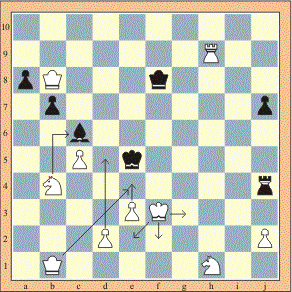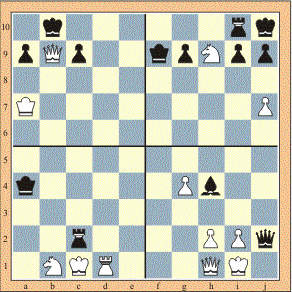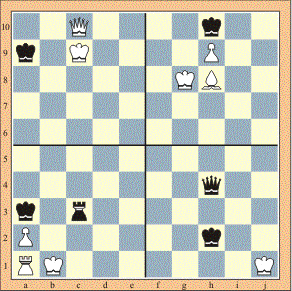The white King on b1, j1 is stalemat.
The black King on a9, h10 is stalemat.
The black King is in position of continuous check.The black Civilian on e10 can't capture the white Queen on c10
DRAWN GAME
The game is drawn when neither of the players can't checkmate the opponents King. In that situation the game ends and both of the players win half of the point. There are a few possibilities for a game to be drawn:
Stalemate; when one of the players can't make a move with neither of his remaining pieces but his king is not under attack, then his king is said to be "stalemated".
Continuous chess is a situation when one of the players continually puts the opponents king in the check position and the opponent doesn't have the means to defend himself from the opponents attacks. This way of drawing a game is usually used by the player who is in weaker position either materially or strategically.
Repeating the same move can result a drawn game, if the same move is repeated three times and if the player demands a draw before repeating the move for the third time.
A draw with the consent is when both of the players are in equal position and they agree to declare the game drawn.
An objective draw is when both of the players can't checkmate the opponents King.
Next: page 6
Written by Redzo Kolakovic.
WWW page created: August 7, 2005.
If one piece is stopped on it's way by an opponents piece, there is an option of making a capture of the opponents piece.
Diagram shows a position of white and black pieces on the chessboard. We can see, that Civilians in this position can't make a capture, although themselves can be captured by opponents pieces, but still...
The white Bishop on f9 can capture black Civilian on g10. In this case has the player with black pieces two possibilities to capture white Bishop on g10. Black Civilian can capture white Bishop on g10 by moving from i9 to g10 (like the Knight). The other possibility is that the black King captures the white Bishop by moving from f10 to g10.
Another example:
Black Bishop on e7 can capture the white Pawn on a3. In this case has the white Civilian an option to move diagonally from c1 and capture the black Bishop on a3.
But if any of the Civilians decides to make a capture, they have to do it immediately. Later the right to make a capture ceases to exist.
Considering the movement capability of the pieces we can say that the Civilian is the most valuable piece, the second is the Queen and then follow the Rook, the Bishop, the Knight, the King and the Pawn. Examining the game of Chess'3 as a whole we can conclude that pieces can increase or decrease their values according to the situation.
Diagram shows a possible way of defending the white King on f3 after it was attacked by the black bishop on c6.
Four possible checkmate position.
CHECK
The main piece of chess'3 still remains the king. There can be no game of chess'3 without the king. Other pieces can be attacked or captured by opponents pieces. However, if the King is attacked by the opponent's piece (is in check), it has to defend it self. There are three ways to defend the King:
-by moving it to a safe (unattacked) field
-by capturing the attacking piece
-by blocking the way between attacking piece and the king with another piece.
CHECKMATE
The final goal of the game is to checkmate the opponents King. The checkmate is a situation where the King is in check in that way that it can't be defended (neither by redrawing, blocking, nor by capturing the attacking piece). The player who checkmated the opponent is the winner and he gets one point. The game of chess is then completed. The game can also be ended without the checkmate if one of the players declares he resigns. For the checkmate position are required at least two pieces.




